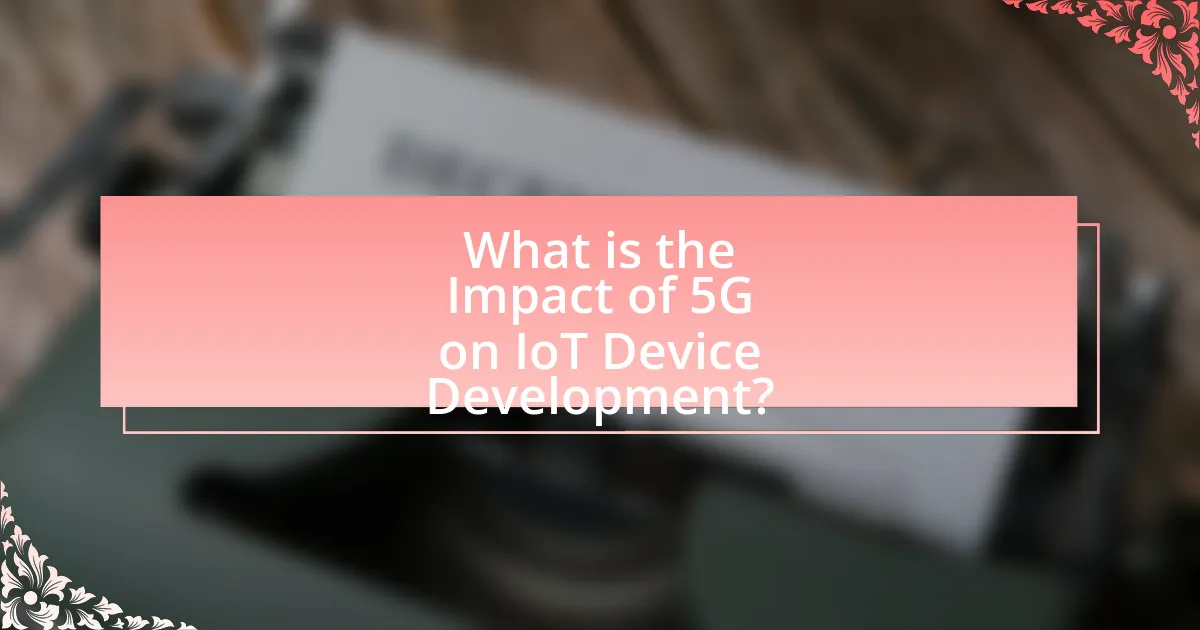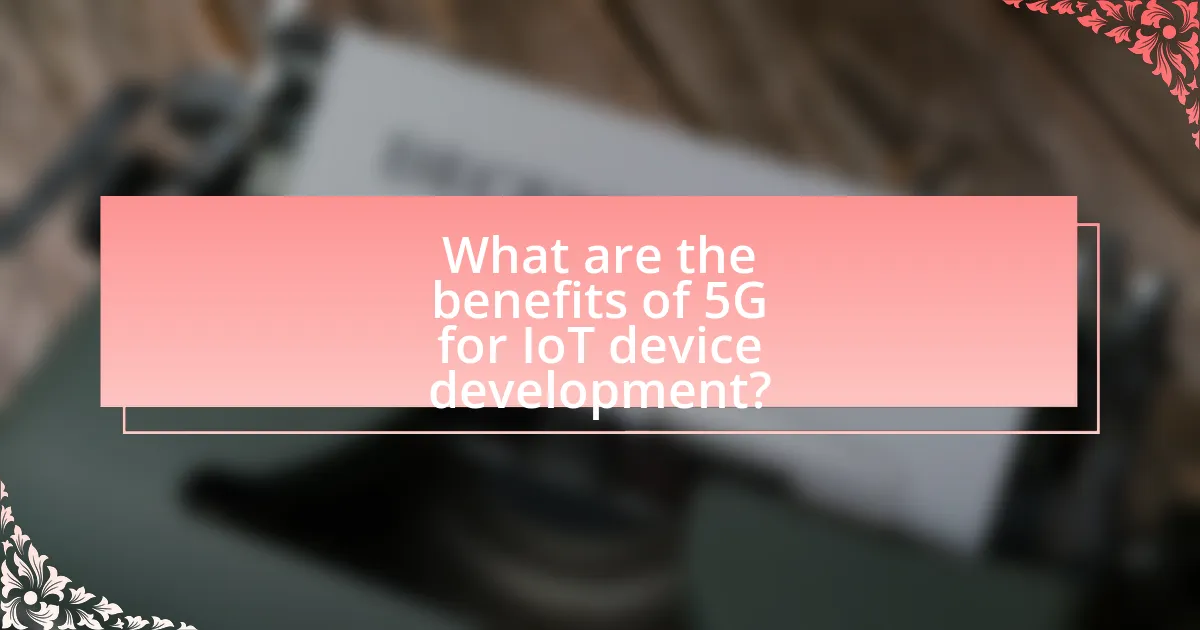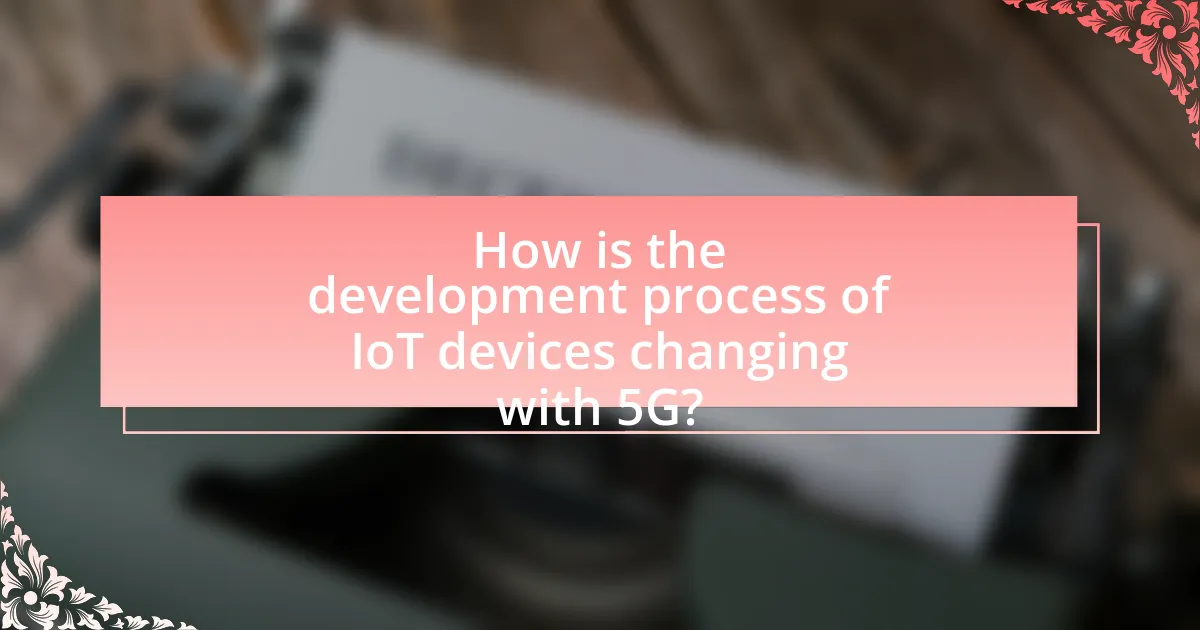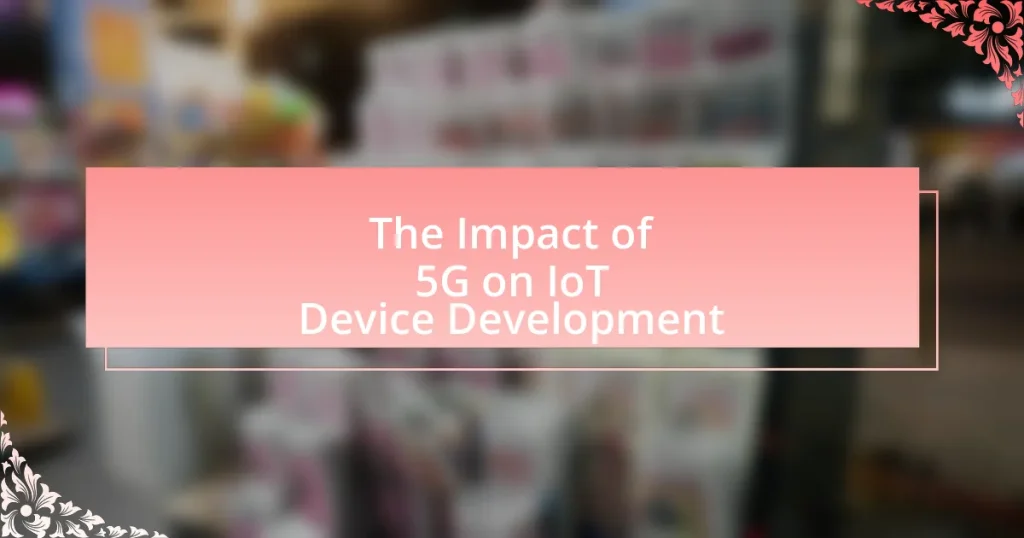The article focuses on the impact of 5G technology on the development of Internet of Things (IoT) devices. It highlights how 5G enhances IoT capabilities through faster data transfer speeds, lower latency, and increased connectivity, enabling real-time communication essential for applications such as smart cities, autonomous vehicles, and remote healthcare. The article also addresses the challenges of integrating 5G with IoT devices, including network complexity, security vulnerabilities, and interoperability issues. Additionally, it discusses the implications for device design, software development, and future trends in IoT, emphasizing the transformative potential of 5G across various industries.

What is the Impact of 5G on IoT Device Development?
5G significantly enhances IoT device development by providing faster data transfer speeds, lower latency, and increased connectivity. This technology enables IoT devices to communicate in real-time, facilitating applications such as smart cities, autonomous vehicles, and remote healthcare. For instance, 5G can support up to one million devices per square kilometer, compared to 4G’s 100,000, allowing for a denser network of interconnected devices. Additionally, the reduced latency of 1 millisecond in 5G networks compared to 30-50 milliseconds in 4G improves the responsiveness of IoT applications, making them more efficient and reliable.
How does 5G technology enhance IoT device capabilities?
5G technology enhances IoT device capabilities by providing significantly higher data transfer speeds, lower latency, and increased connectivity. These improvements enable IoT devices to communicate more efficiently and effectively, allowing for real-time data processing and analysis. For instance, 5G can support up to one million devices per square kilometer, compared to 4G’s limit of around 100,000 devices, facilitating the deployment of dense IoT networks. Additionally, the latency in 5G networks can be as low as one millisecond, which is crucial for applications requiring immediate response, such as autonomous vehicles and remote surgeries. This combination of speed, capacity, and responsiveness fundamentally transforms how IoT devices operate and interact within various ecosystems.
What specific features of 5G contribute to improved IoT performance?
The specific features of 5G that contribute to improved IoT performance include enhanced bandwidth, lower latency, and increased device density. Enhanced bandwidth allows for faster data transmission, enabling IoT devices to communicate more efficiently and process larger amounts of data simultaneously. Lower latency, which can be as low as 1 millisecond, facilitates real-time communication between devices, crucial for applications like autonomous vehicles and remote surgery. Increased device density supports up to one million devices per square kilometer, allowing for a greater number of IoT devices to operate in close proximity without interference, which is essential for smart cities and industrial automation. These features collectively enhance the reliability, speed, and scalability of IoT applications.
How does 5G reduce latency for IoT applications?
5G reduces latency for IoT applications by utilizing advanced technologies such as millimeter waves, massive MIMO (Multiple Input Multiple Output), and network slicing. These technologies enable faster data transmission and more efficient use of the available spectrum, resulting in latency as low as 1 millisecond compared to 4G’s average of 30-50 milliseconds. This significant reduction in latency enhances real-time communication and responsiveness in IoT applications, which is critical for use cases like autonomous vehicles and remote surgery.
What are the potential challenges of integrating 5G with IoT devices?
The potential challenges of integrating 5G with IoT devices include network complexity, security vulnerabilities, and interoperability issues. Network complexity arises from the need for advanced infrastructure to support the high-speed and low-latency requirements of 5G, which can complicate deployment and maintenance. Security vulnerabilities are heightened due to the increased number of connected devices, making them more susceptible to cyberattacks; a report by the Cybersecurity & Infrastructure Security Agency (CISA) highlights that IoT devices often lack robust security measures. Interoperability issues occur because various IoT devices may use different communication protocols, making seamless integration with 5G networks difficult. These challenges must be addressed to fully realize the benefits of 5G in IoT applications.
What security concerns arise with 5G-enabled IoT devices?
5G-enabled IoT devices face significant security concerns, primarily due to their increased connectivity and the vast number of devices involved. The expanded attack surface allows cybercriminals to exploit vulnerabilities, leading to potential data breaches, unauthorized access, and denial-of-service attacks. For instance, a report by the European Union Agency for Cybersecurity (ENISA) highlights that the integration of 5G technology can amplify risks associated with device authentication and data integrity, as the speed and volume of data transmission increase. Furthermore, the reliance on cloud services for data processing in 5G networks raises concerns about data privacy and the potential for centralized points of failure, making these devices more susceptible to coordinated attacks.
How does the cost of 5G infrastructure affect IoT device development?
The cost of 5G infrastructure significantly impacts IoT device development by influencing investment decisions and the affordability of devices. High infrastructure costs can lead to increased prices for IoT devices, as manufacturers may pass on expenses to consumers. For instance, a report by the Global System for Mobile Communications (GSMA) indicates that the total cost of 5G network deployment could reach $1 trillion globally by 2025, which may deter smaller companies from entering the market. Consequently, this financial barrier can slow innovation and limit the variety of IoT devices available, as only well-funded companies can afford to develop and deploy new technologies.

What are the benefits of 5G for IoT device development?
5G significantly enhances IoT device development by providing higher data speeds, lower latency, and increased connectivity. The higher data speeds, reaching up to 10 Gbps, enable IoT devices to transmit large amounts of data quickly, which is essential for applications like real-time video streaming and advanced analytics. Lower latency, as low as 1 millisecond, allows for instantaneous communication between devices, crucial for applications requiring immediate responses, such as autonomous vehicles and remote surgery. Additionally, 5G supports a massive number of connected devices per square kilometer, estimated at over one million, facilitating the deployment of dense IoT networks in smart cities and industrial environments. These benefits collectively drive innovation and efficiency in IoT device development.
How does 5G improve data transmission for IoT devices?
5G significantly improves data transmission for IoT devices by offering higher bandwidth, lower latency, and increased connection density. The technology enables data rates up to 10 Gbps, which is substantially faster than previous generations, allowing IoT devices to transmit large amounts of data quickly and efficiently. Additionally, 5G reduces latency to as low as 1 millisecond, facilitating real-time communication between devices, which is crucial for applications like autonomous vehicles and remote surgery. Furthermore, 5G can support up to 1 million devices per square kilometer, enhancing the scalability of IoT networks and enabling more devices to connect simultaneously without degradation in performance. These advancements collectively enhance the functionality and reliability of IoT applications across various sectors.
What role does increased bandwidth play in IoT applications?
Increased bandwidth plays a crucial role in IoT applications by enabling faster data transmission and supporting a higher number of connected devices. This enhancement allows IoT systems to process and analyze large volumes of data in real-time, which is essential for applications such as smart cities, autonomous vehicles, and remote healthcare. For instance, 5G technology, which offers bandwidth up to 100 times greater than 4G, facilitates seamless communication between devices, reducing latency and improving overall system efficiency. This capability is vital for applications requiring immediate responses, such as industrial automation and emergency services, where delays can lead to significant consequences.
How does 5G support a larger number of connected devices?
5G supports a larger number of connected devices by utilizing advanced technologies such as massive MIMO (Multiple Input Multiple Output) and network slicing. Massive MIMO increases the capacity of the network by allowing multiple signals to be transmitted simultaneously over the same frequency, significantly enhancing the number of devices that can connect at once. Network slicing enables the creation of multiple virtual networks within a single physical 5G network, allowing for tailored connectivity solutions that can accommodate diverse device requirements and use cases. According to the International Telecommunication Union, 5G networks can support up to one million devices per square kilometer, compared to 4G’s maximum of around 100,000 devices, demonstrating the substantial increase in capacity and efficiency that 5G technology provides.
What industries are most impacted by 5G in IoT development?
The industries most impacted by 5G in IoT development include healthcare, manufacturing, transportation, and smart cities. In healthcare, 5G enables real-time remote monitoring and telemedicine, enhancing patient care and operational efficiency. Manufacturing benefits from improved automation and real-time data analytics, leading to increased productivity and reduced downtime. Transportation sees advancements in connected vehicles and smart traffic management systems, which enhance safety and efficiency. Smart cities leverage 5G for better infrastructure management, energy efficiency, and enhanced public services. These impacts are supported by the increased bandwidth, lower latency, and greater device connectivity that 5G technology provides, facilitating the growth and innovation of IoT applications across these sectors.
How is the healthcare sector leveraging 5G for IoT solutions?
The healthcare sector is leveraging 5G for IoT solutions by enabling real-time data transmission and enhancing remote patient monitoring capabilities. With 5G’s low latency and high bandwidth, healthcare providers can utilize connected devices to monitor patients’ vital signs continuously, facilitating timely interventions. For instance, a study by the International Telecommunication Union highlights that 5G can support up to one million devices per square kilometer, allowing hospitals to deploy numerous IoT devices simultaneously without network congestion. This capability improves patient outcomes and operational efficiency, demonstrating the transformative impact of 5G on healthcare IoT applications.
What advancements are seen in smart cities due to 5G and IoT?
Advancements in smart cities due to 5G and IoT include enhanced connectivity, real-time data processing, and improved efficiency in urban services. The implementation of 5G technology allows for faster data transmission and lower latency, enabling IoT devices to communicate seamlessly. For instance, smart traffic management systems can analyze real-time traffic data to optimize traffic flow, reducing congestion by up to 30% in some cities. Additionally, 5G supports a higher density of connected devices, facilitating the deployment of smart sensors for environmental monitoring, waste management, and energy efficiency. These advancements lead to more sustainable urban environments and improved quality of life for residents.

How is the development process of IoT devices changing with 5G?
The development process of IoT devices is changing significantly with the advent of 5G technology, primarily due to enhanced speed, lower latency, and increased connectivity. 5G networks can support a massive number of devices simultaneously, allowing for more complex and data-intensive applications in IoT. For instance, 5G can reduce latency to as low as 1 millisecond, enabling real-time data processing and communication, which is crucial for applications like autonomous vehicles and smart cities. Additionally, the higher bandwidth provided by 5G allows IoT devices to transmit larger volumes of data more efficiently, facilitating advancements in areas such as remote monitoring and smart healthcare. This shift is supported by industry reports indicating that 5G is expected to connect over 1.5 billion IoT devices by 2025, highlighting its transformative impact on the development landscape of IoT technologies.
What new design considerations arise for IoT devices in a 5G environment?
New design considerations for IoT devices in a 5G environment include enhanced connectivity, energy efficiency, and security protocols. The increased bandwidth and lower latency of 5G enable IoT devices to handle more data and communicate in real-time, necessitating designs that can leverage these capabilities effectively. Additionally, energy efficiency becomes critical as devices will be expected to operate longer on battery power while maintaining high performance. Security protocols must also be upgraded to address the increased number of connected devices and potential vulnerabilities, as evidenced by the projected growth of IoT devices to over 75 billion by 2025, which highlights the need for robust security measures.
How does 5G influence the choice of sensors and components in IoT devices?
5G significantly influences the choice of sensors and components in IoT devices by enabling higher data rates, lower latency, and increased connectivity. This advancement allows for the integration of more sophisticated sensors that require real-time data processing and transmission, such as high-definition cameras and advanced environmental sensors. For instance, the low latency of 5G, which can be as low as 1 millisecond, supports applications like autonomous vehicles that rely on immediate feedback from multiple sensors. Additionally, the increased bandwidth of 5G facilitates the use of more complex components, such as edge computing devices, which can process data locally before sending it to the cloud, thereby reducing the amount of data transmitted and improving response times.
What are the implications for software development in 5G-enabled IoT?
The implications for software development in 5G-enabled IoT include the need for enhanced scalability, improved security protocols, and the integration of edge computing. 5G technology supports a significantly higher number of connected devices, estimated at up to one million devices per square kilometer, which necessitates software that can efficiently manage and scale with this increased connectivity. Additionally, the low latency of 5G, around one millisecond, requires developers to implement real-time data processing capabilities, enhancing the responsiveness of IoT applications. Furthermore, the increased data transfer speeds and bandwidth of 5G demand robust security measures to protect sensitive information, leading to the development of more sophisticated encryption and authentication methods. These factors collectively drive a shift in software development practices to accommodate the unique requirements of 5G-enabled IoT environments.
What are the future trends in IoT device development with 5G?
Future trends in IoT device development with 5G include enhanced connectivity, increased device density, and improved energy efficiency. The implementation of 5G technology allows for faster data transmission rates, enabling real-time communication between devices, which is crucial for applications like autonomous vehicles and smart cities. Additionally, 5G supports a higher number of connected devices per square kilometer, facilitating the growth of IoT ecosystems. According to a report by the GSMA, 5G networks are expected to connect over 1.5 billion IoT devices by 2025, highlighting the significant impact of 5G on the scalability of IoT solutions. Furthermore, advancements in edge computing, driven by 5G, will allow IoT devices to process data locally, reducing latency and bandwidth usage, which is essential for applications requiring immediate responses.
How might 5G shape the evolution of smart home devices?
5G will significantly enhance the evolution of smart home devices by providing faster data transfer speeds, lower latency, and increased connectivity. This technology enables smart home devices to communicate in real-time, allowing for more responsive automation and control. For instance, 5G can support a higher density of connected devices, facilitating seamless integration of various smart home technologies such as security systems, lighting, and appliances. According to a report by the GSMA, 5G networks can achieve speeds up to 10 Gbps, which is crucial for applications requiring high bandwidth, such as 4K video streaming and augmented reality experiences within smart homes. Additionally, the reduced latency of 1 millisecond compared to 4G enhances the performance of time-sensitive applications, improving user experience and operational efficiency.
What innovations can we expect in industrial IoT with 5G technology?
5G technology will drive significant innovations in industrial IoT by enabling ultra-reliable low-latency communication, massive device connectivity, and enhanced data processing capabilities. These advancements will facilitate real-time monitoring and control of industrial processes, allowing for improved automation and efficiency. For instance, 5G can support up to one million devices per square kilometer, which is crucial for densely populated industrial environments. Additionally, the reduced latency of 1 millisecond or less will enhance the responsiveness of applications such as remote robotics and autonomous vehicles in manufacturing settings. This combination of high capacity and low latency will ultimately lead to smarter factories and optimized supply chains, transforming the landscape of industrial operations.
What best practices should developers follow for 5G IoT device integration?
Developers should follow several best practices for 5G IoT device integration, including ensuring compatibility with 5G standards, optimizing power consumption, and implementing robust security measures. Compatibility with 5G standards is crucial as it guarantees that devices can effectively utilize the high-speed, low-latency capabilities of 5G networks. Optimizing power consumption is essential because many IoT devices operate on battery power, and efficient energy use extends device lifespan. Implementing robust security measures is vital to protect sensitive data transmitted over 5G networks, as increased connectivity also raises the risk of cyber threats. These practices are supported by industry guidelines from organizations like the 3rd Generation Partnership Project (3GPP), which outlines standards for 5G technology and its applications in IoT.


